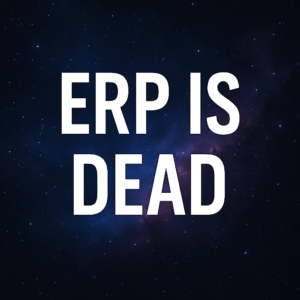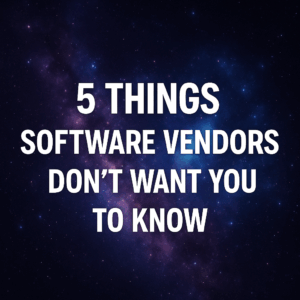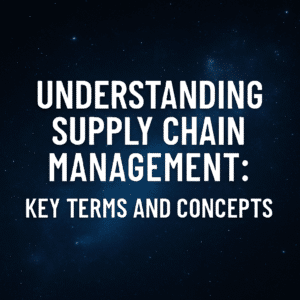Organizations typically implement new ERP software because they want to realize some sort of return on investment or business value as a result of that technology. But what exactly are the business benefits of ERP software?
One of the most common technologies that organizations deploy as part of their transformation is ERP software. There are dozens, if not hundreds, of ERP systems out there in the marketplace, but I won’t dive into the details of the differences between those systems or what some of the options are. Instead, what I want to do is talk about some of the key business benefits of why organizations implement ERP software. If they implement ERP software effectively, what is the business value that they typically achieve?

Table of Contents
ToggleCost Reduction
Now, the first category of business benefits that most organizations look for when implementing new ERP software is cost reduction. This is probably the most common business benefit that organizations are striving for as they look for ways to reduce their current cost structure. I’ll give you a few examples of what some of the potential cost reductions might be. For a lot of organizations, the first is inventory reduction.
Inventory Reduction
Often, organizations without good ERP technology or visibility into what’s happening in their supply chain end up stockpiling inventory more than they need. This is a big deal because it’s almost like cash out the door. You’ve got cash sitting in warehouses and in your production manufacturing shop floors when you overproduce. If you can reduce inventory without compromising customer service and still meeting expectations, then inventory reduction can be a very significant business benefit that a lot of organizations realize as a result of a fully integrated ERP system.
Better Planning
Better planning is another business benefit that has a direct impact on the ROI of the ERP implementation. This is not only demand planning but also customer planning and production planning, making sure that you have the raw materials in the right place at the right time to produce the right products at the right time to meet customer demand. The whole integrated planning cycle is a key benefit of ERP software implementations.
Process Efficiency
Another benefit is process efficiency. Many organizations have inefficient processes, including manual and redundant processes, and people using spreadsheets to manually find information that can be automated and streamlined. If they had a better tool set, a better ERP system to help tie together some of these workflows and provide more automated workflows, labor costs could be reduced. Labor costs are one of the most significant costs on many organizations’ income statements, so providing better process efficiency and optimizing business processes can be a game-changer in terms of the financial performance of an organization.
Cost of Legacy Systems
Finally, the cost of legacy systems is another example. Organizations sometimes use old, outdated systems that are expensive to maintain. They may need to hire third-party support or people internally just to maintain and keep the lights on with these older systems. Over time, the older the technology gets, the more costly it is to maintain it because it’s harder to find people who know that technology. For example, in the 1970s and 80s, many organizations were using green screen mainframe systems. These are very old, outdated technologies that are hard to find resources for nowadays. That’s just an extreme example of how costs can escalate for organizations when they’re using old, outdated technologies, and that’s why the cost of legacy systems is so significant and can provide such big business value for organizations.
Revenue Optimization
I mentioned before that most organizations focus on cost reduction. That’s probably the most common business benefit that organizations pursue. But one of the benefits that I think is the most underrated with ERP software is revenue optimization. In other words, not just looking at your cost and making sure you reduce costs, but looking at how we can grow the top line in addition to the bottom line. Revenue optimization is really important, and there are a few ways that this happens.
Firstly, if you look at some of these cost reductions here, such as inventory reduction, that allows you to optimize revenue because you’re matching customer demand to inventory in a better way than you might have with older technologies. So inventory reduction actually gives you some revenue optimization as well. Same with better planning. If we have a better understanding of what customer demand is going to be or is likely to be, that’s going to result in revenue optimization as well because we’re going to sell more to our customers. Ultimately, even process efficiency can drive revenue increases too because now you’ve got people that are focused more potentially on driving top line revenue growth and spending less time on some of these inefficient processes that I described here.
In addition to some of these cost reduction benefits that are also driving revenue optimization, you also have increased sales. The reason that I’m calling this out as a separate line item is that with CRM or customer relationship management tools and other sales automation tools and other types of modules within ERP systems, what often happens is it gives you better tool sets to be able to sell more to your customers. For example, if you manage your sales pipeline better and increase your win rate, that’s going to increase revenue. Another example of how ERP software can optimize your revenue is through cross-selling opportunities. If you have a product or service that you’re selling to a customer, it’s quite possible that you have another product or service that you could also be selling to that customer. So if you can provide automation and tools and technology that provide you with those insights through machine learning and artificial intelligence and other sorts of emerging technologies to help you do that, then you’re going to be able to increase your sales as a result of your new ERP system.
While most organizations don’t focus as much on revenue optimization as they might on cost reduction, I would argue that the potential gain and the potential business value are even greater for revenue optimization than it is for cost reduction.
Strategic or Intangible Benefits
So far, we have focused pretty exclusively on really tangible, measurable business benefits in terms of cost reduction and revenue optimization. But there’s also another category called strategic or intangible benefits. These are benefits that are harder to quantify, so we’ll just call them strategic benefits here. They’re important benefits that are important to our business and our business model and what we’re trying to accomplish, but they are difficult to measure. And as I’m going to talk about here in a moment, I would argue that you should try to quantify as many of these as you can, even if it’s difficult.
Let me give you an example. One would be to increase customer satisfaction or the customer experience, however you want to view that. But a lot of times, organizations will use ERP software to be able to provide better visibility into order status and to provide better visibility into what inventory is available and in stock. That just provides a more positive customer experience.
Now, while a lot of organizations view this as a strategic intangible benefit that can’t be measured, we always argue to our clients or suggest to our clients that they should focus on trying to quantify these. For example, increasing customer satisfaction typically will result in more revenue optimization. So if we can increase customer satisfaction from, say, 90 to 95 just as an example, what could that do or what is that likely to do to our overall revenue? It’s one thing to just do this for customer satisfaction’s sake and just to be good in the marketplace. We also, more importantly, want to make sure we’re doing this in a way that optimizes revenue.
Another example would be to increase the employee experience. If we provide better tools to our employees, they should be able to do their jobs better, be happier, and experience less attrition or turnover. Again, if we’re increasing employee satisfaction, what is the tangible value that comes out of that? I would argue that it’s probably going to reduce costs because we will spend less time having to rehire and retrain employees. Inefficient workforce morale issues can also be costly to an organization. Therefore, if we can reduce the cost associated with low employee satisfaction by improving it, we should try our best to quantify the potential cost reduction. These are just a couple of examples.
Your organization might have other needs or goals they are trying to achieve. For example, standard processes are a common one we hear from our client organizations. This is a high-value one that we should absolutely try to quantify. Many organizations think that this is a strategic business benefit that cannot be quantified, but we know we want to implement ERP software to help us achieve it. If we implement it well, it will drive other business benefits that we should quantify. Therefore, the message here is that if executive team members suggest these strategic benefits for your ERP implementation, you should also do your best to quantify them and build them into your business case.
Negative Business Benefit
Now, the other business benefit worth noting here is almost the inverse of a business benefit, and that is negative business benefits. In other words, there are some implementation costs associated with implementations, or some opportunity costs associated with them.
I’ll describe what I mean here. So, negative business benefits would be things like lost productivity for a certain period of time. No matter how well we manage our implementation, we’re going to have a certain loss in productivity with our employees. They’re just going to be less efficient on day one of a new system than they were with the old system, simply because they’re not comfortable with or used to the new system.
We can certainly do all we can to minimize this, and we absolutely should. We should make sure we manage the implementation well, make sure that we do change management, training, and communications really well to minimize this lost productivity. But we do have to quantify this as a potential cost, and that’s really the way that you may want to look at this too. There are not only just negative business benefits that undermine or take away from some of these benefits to give you a net business benefit, but it’s also oftentimes viewed as a cost of implementation.
So, we have our software costs, our direct implementation costs, and other things related to the transformation. But then you’ve got these secondary indirect costs that are related to the implementation, things like lost productivity. And then you have other costs or negative business benefits related to the investment in new technology, such as subscription costs of software.
There’s usually a net difference between the new cost structure of a subscription cloud-based software model and the old on-premise model that you might have had in the past. Assuming you’re moving from on-premise to cloud solutions, you’re going to have a totally different cost structure. And what you typically find is that over time, usually five to seven years out, subscription costs for SaaS or cloud solutions are going to be more expensive than on-premise. Yes, you get all these business values and all these business benefits over here, but to really understand your real ROI and your real cost-benefit analysis, you need to understand what this cost difference is. And that’s a negative business benefit that a lot of organizations don’t recognize, and a lot of software vendors will tell you is not true, but is absolutely true. So, you need to make sure you quantify these costs as well.
Another potential negative benefit would be if you implement a new emerging technology or a new type of technology that requires you to increase your staff to support the system. If there’s some sort of proprietary development language that you need to hire to bring on your staff, or if it just requires more people, more bodies to maintain the software because it’s more complex, there’s more integration, there are more data management issues that need to be worked through, then you need to quantify those costs as well.
So, we want to make sure that we also capture the internal maintenance costs of the new solution. This is different from the maintenance of your old solution, which may turn out that the old solution cost of legacy systems is higher than what you’re paying to support this new system. But you still want to make sure you capture this. It could also be that you end up paying more for your internal maintenance of the new technology than you did with your legacy systems, which may be okay if these benefits over here outweigh these negative benefits or the cost of the implementation.
Then it’s probably worth it, but you at least want to make sure you quantify this and understand what those negative business benefits are. Now, once you’ve done all this and you understand what your business benefits are and you’ve quantified those in your business case, now you want to build that business case. You want to look at what the total cost of ownership is, the total cost of your implementation against the business benefits that we talked about here today.
If you are looking to strategize an upcoming transformation or are looking at selecting an ERP system, we would love to give you some insights. Please contact me for more information eric.kimberling@thirdstage-consulting.com





